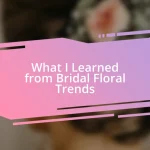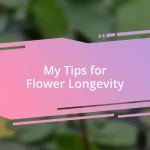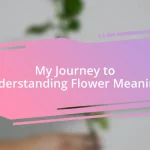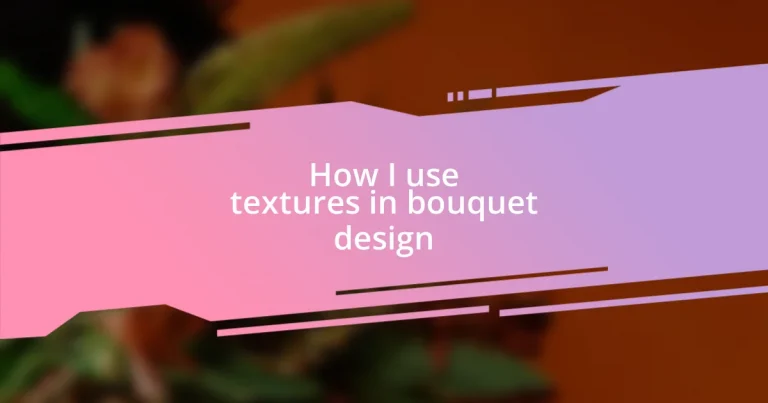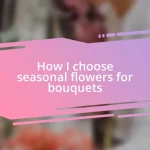Key takeaways:
- Combining different textures in floral arrangements enhances visual interest and evokes emotional responses, making each bouquet tell a unique story.
- Seasonal textures play a significant role in bouquet design, with each season inspiring specific materials that reflect its essence and evoke corresponding feelings.
- Techniques such as layering, contrasting colors, and incorporating unexpected elements can elevate bouquet texture, creating dynamic arrangements that captivate viewers.
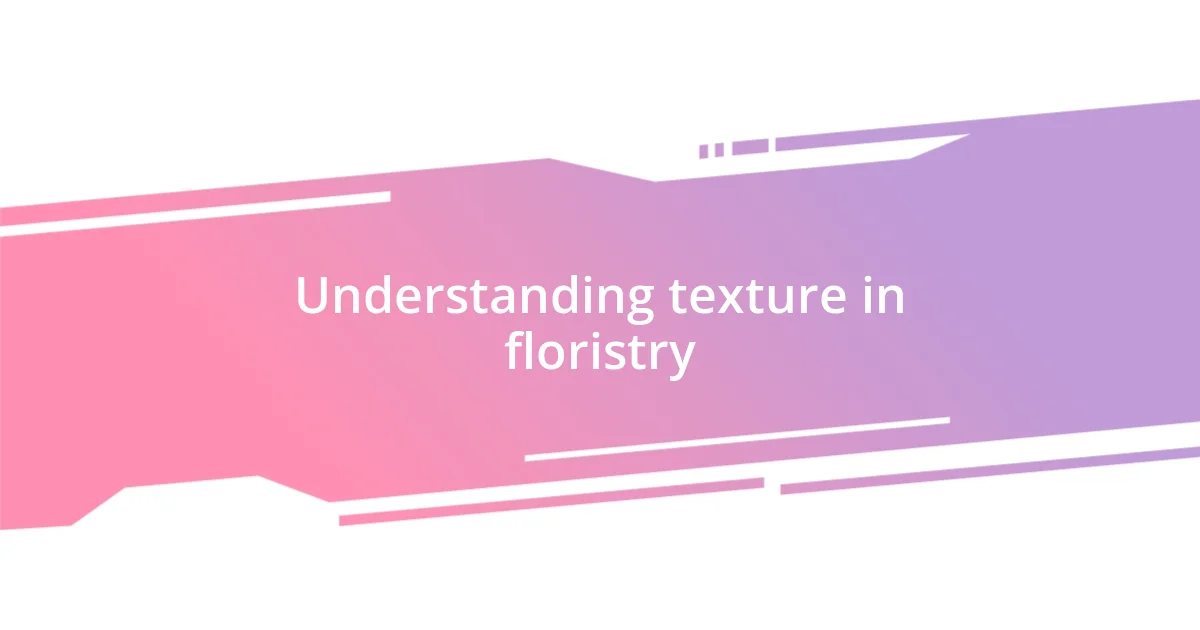
Understanding texture in floristry
Texture in floristry is like the secret ingredient that adds depth and character to a bouquet. When I think about my own designs, I often reflect on how a sleek, glossy petal can contrast beautifully with the rough edges of a dried leaf. Have you ever noticed how such contrasts can elevate the overall aesthetic? It’s almost like a conversation between the flowers, where each player has a unique role to fulfill.
In my experience, combining various textures not only creates visual interest but also evokes an emotional response. For example, when I include velvety blooms alongside spiky thorns, it tells a story of resilience and softness. Isn’t it fascinating how you can communicate feelings through the choice of materials? Each texture can bring memories flooding back, just like the scent of nostalgia in a single flower.
I often find myself experimenting with unexpected materials, like incorporating rustic twigs or feathers. The thrill of discovering how they interact with delicate blooms is invaluable. It’s a reminder that floral design is not just about aesthetics—it’s about creating an experience, one that resonates deeply with both the designer and the viewer. So, what textures will you explore in your next bouquet?
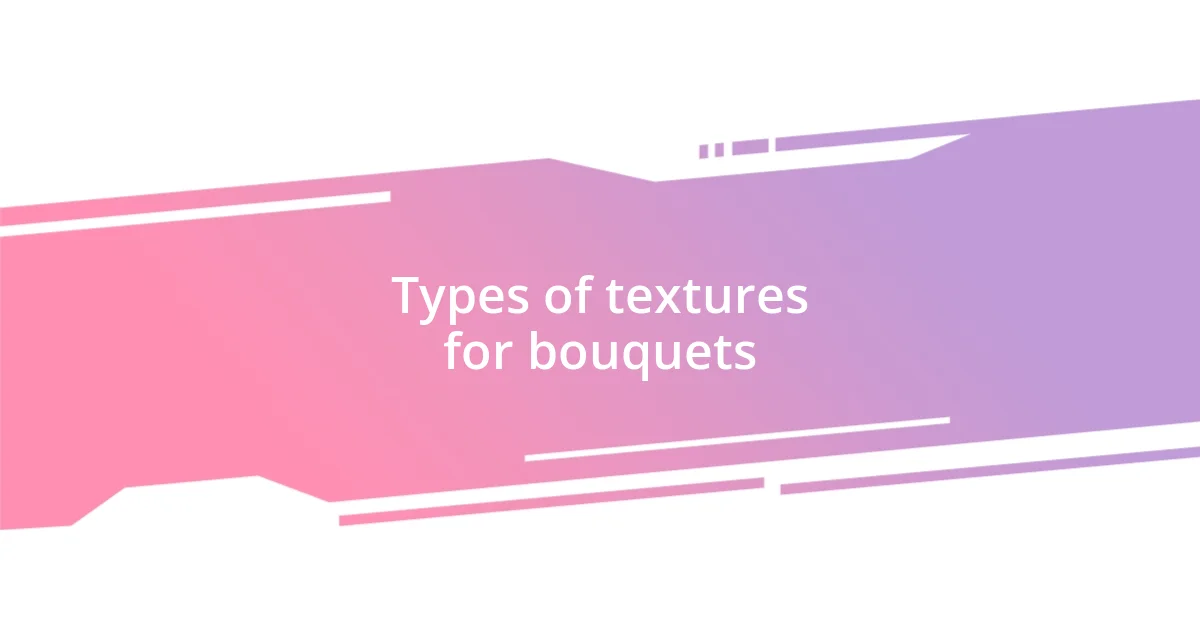
Types of textures for bouquets
When I design a bouquet, the variety of textures available to me is truly exciting. I often think about how different materials can dramatically influence the overall feel of the arrangement. For instance, the boldness of waxy leaves juxtaposed with the fragility of lacey floral varieties can evoke feelings of softness intertwined with strength, capturing a delightful tension that I find visually intriguing.
Here are some textures I like to incorporate into my bouquets:
- Smooth: Think of silky petals from roses or peonies, which bring a luxurious feel.
- Rough: Add in textured elements like dried thistles or bark to give depth and contrast.
- Velvety: Flowers like tulips or pansies have a soft, plush touch that can create warmth.
- Spiky: Incorporating elements like succulents or certain types of foliage adds a striking visual element.
- Transparent: Using delicate materials like muslin or sheer fabrics can create an ethereal quality.
Every time I reach for different textures, I find myself recalling a specific moment—like feeling the rough bark of a branch in my hand during a nature walk. It reminds me that each texture tells a story, and crafting a bouquet is like piecing together a beautiful narrative filled with emotions and memories.
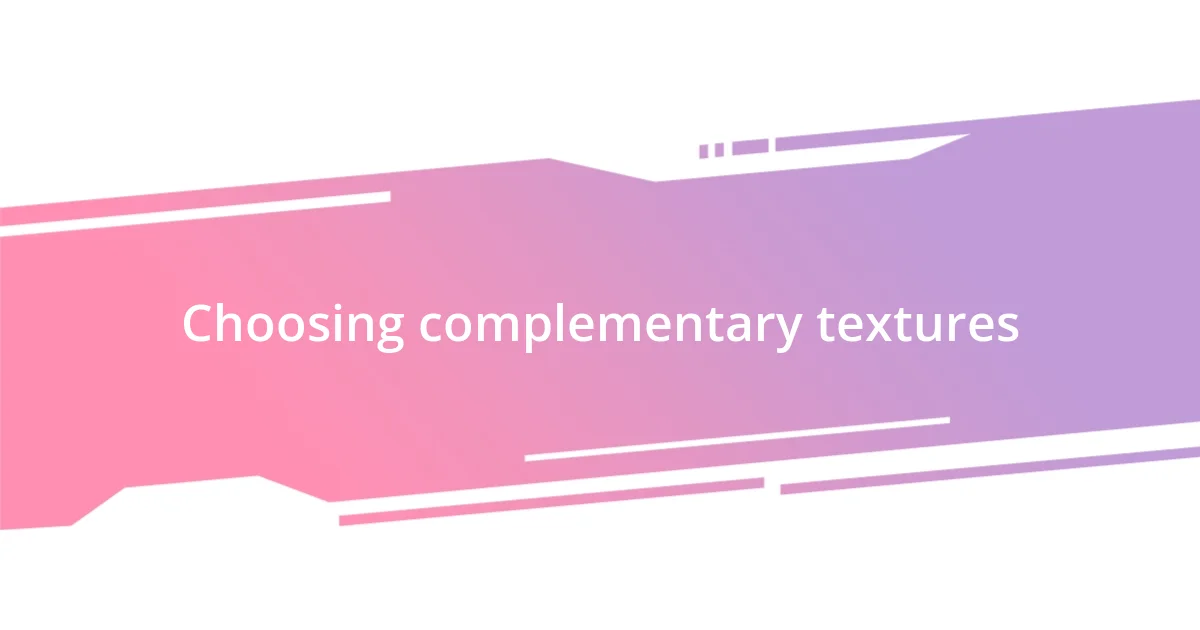
Choosing complementary textures
Choosing complementary textures can truly elevate a bouquet from ordinary to exceptional. When I’m selecting materials, I often think about how the smoothness of a rose petal contrasts with the ruggedness of a dried thistle. This juxtaposition not only adds visual interest but also creates a layered emotional experience for anyone who witnesses the bouquet. Have you ever felt captivated by a simple arrangement that just felt right? That’s the power of thoughtfully chosen textures at play.
Moreover, it’s essential to consider the harmony between textures. I remember a particular wedding bouquet where I paired the delicate fibrous elements of moss with the bold, spiky leaves of a tropical plant. The combination sparked a myriad of conversations at the reception, as guests were drawn to its striking balance. Textures can indeed alter the perception of a bouquet, making the connection between the flowers and the viewer even more impactful. It’s all about finding that perfect synergy.
Finally, I’ve learned to trust my instincts when choosing textures. Sometimes, I incorporate unexpected elements, like a few feathers or a bit of string, just to see how they interact. I vividly recall one time when I tied in some twine with fresh blooms; the rustic feel evoked memories of my grandmother’s garden. The experience taught me that blending textures is not merely a design choice—it’s a journey through memory and creativity. What textures will inspire your next bouquet?
| Texture Type | Description |
|---|---|
| Smooth | Silky petals that create a luxurious feel (e.g., roses) |
| Rough | Textured elements that add depth (e.g., dried thistles) |
| Velvety | Soft and plush flowers that offer warmth (e.g., tulips) |
| Spiky | Striking foliage that enhances visual impact (e.g., succulents) |
| Transparent | Delicate materials for an ethereal quality (e.g., sheers) |
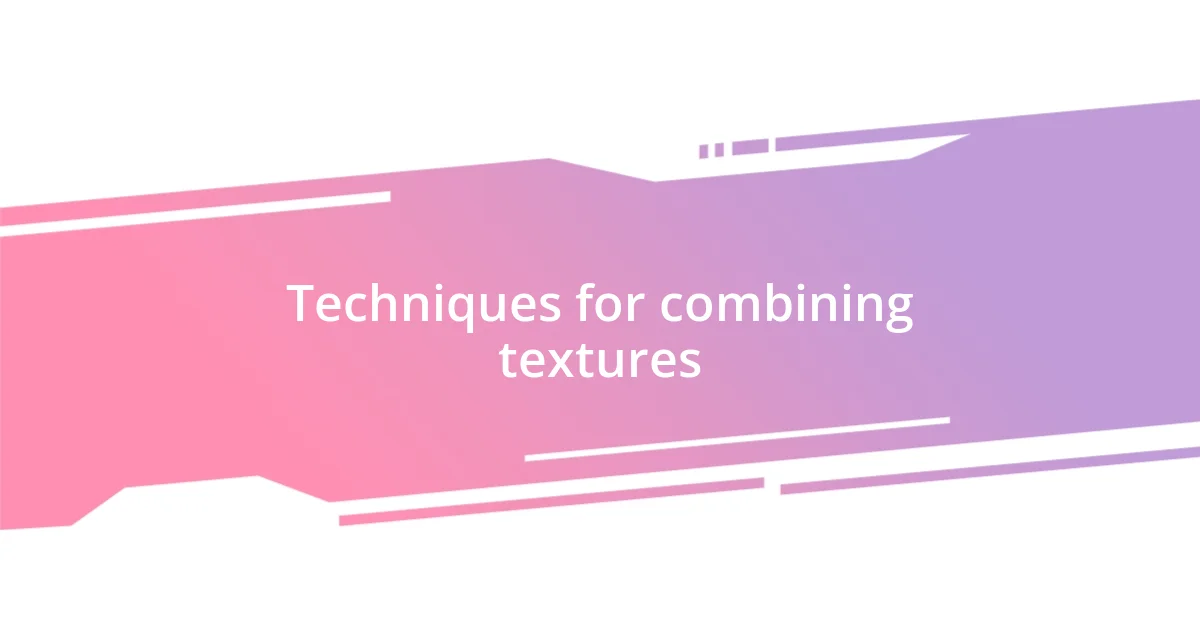
Techniques for combining textures
When I work on combining textures, one of my go-to techniques is layering them based on their visual weight. For instance, I love placing bold, rough textures at the base of my bouquet to create a solid foundation, while lighter, smoother flowers sit atop, giving an airy feel. This approach not only adds dimension but also draws the viewer’s eye upward, creating an inviting focal point—have you ever noticed how a bouquet can seem to dance with depth?
Another technique I appreciate is incorporating contrasting colors alongside varying textures. For example, pairing the vibrant orange of a textured sunflower with a muted, smooth blue hydrangea can make the bouquet pop in a way that feels both exciting and harmonious. I still remember the first time I experimented with this. The bouquet caught my friend’s attention instantly at a gathering, sparking conversations about color and texture interplay. It was one of those moments that made me realize how thoughtful combinations can enhance the emotional impact of a floral design.
Lastly, I believe in the power of movement when combining textures. I often add wispy elements, like dried foliage or feathers, to create a sense of flow in my arrangements. I recall once using flutters of pampas grass to complement the sturdiness of thick daisies; the gentle sway of those grasses brought a certain liveliness that truly transformed the bouquet. How do you think movement in your designs could change the narrative of your arrangements? The right textures not only tell stories—they bring them to life.
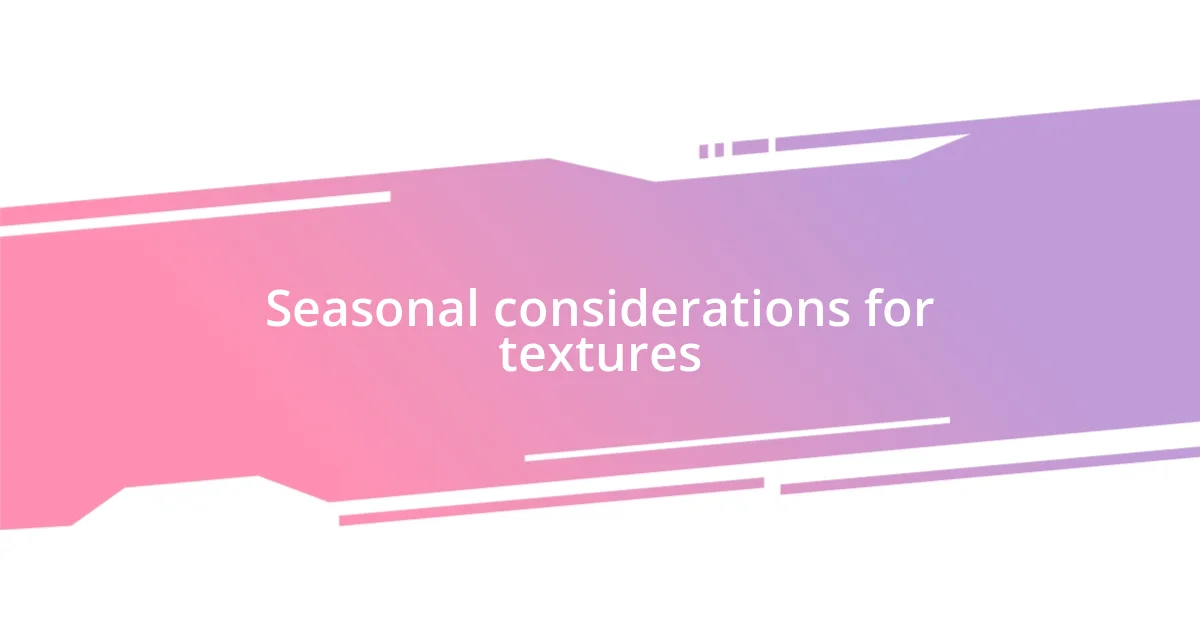
Seasonal considerations for textures
Seasonal considerations for textures can significantly influence the overall feel of a bouquet. For me, spring is all about fresh, delicate textures that evoke feelings of renewal, like the soft petals of peonies coupled with the airy touch of newly sprouted greens. I still smile when I think of a spring wedding where I used a blend of lush, velvety tulips and airy, wispy grasses. The guests remarked on how the bouquet seemed to embody the essence of the season—a true celebration of life awakening.
As summer approaches, I find myself drawn to bolder textures that reflect the vibrancy of the season. Think of the strong, spiky leaves of tropical plants combined with the lush fullness of sunflowers. I vividly remember creating a summer bouquet filled with rich, textured blooms and rattan accents. It radiated warmth and energy, appealing to the sunny disposition of the season. How do you feel when surrounded by brightness? That feeling of joy is precisely what I aim to capture during summer.
When autumn rolls around, I embrace the rustic, earthy textures that speak to the season’s cozy charm. The combination of crisp, dried elements, like pinecones or wheat, with the plushness of dahlias can create a rich tapestry of sensations. I once crafted a bouquet for a fall harvest festival, incorporating deep oranges and rich browns that mirrored the visual depth of the season. Reflecting on that experience, I appreciated how the textures felt like a warm hug, inviting everyone to savor the beauty of autumn. Isn’t it fascinating how seasonal textures can evoke such powerful emotions and connections?
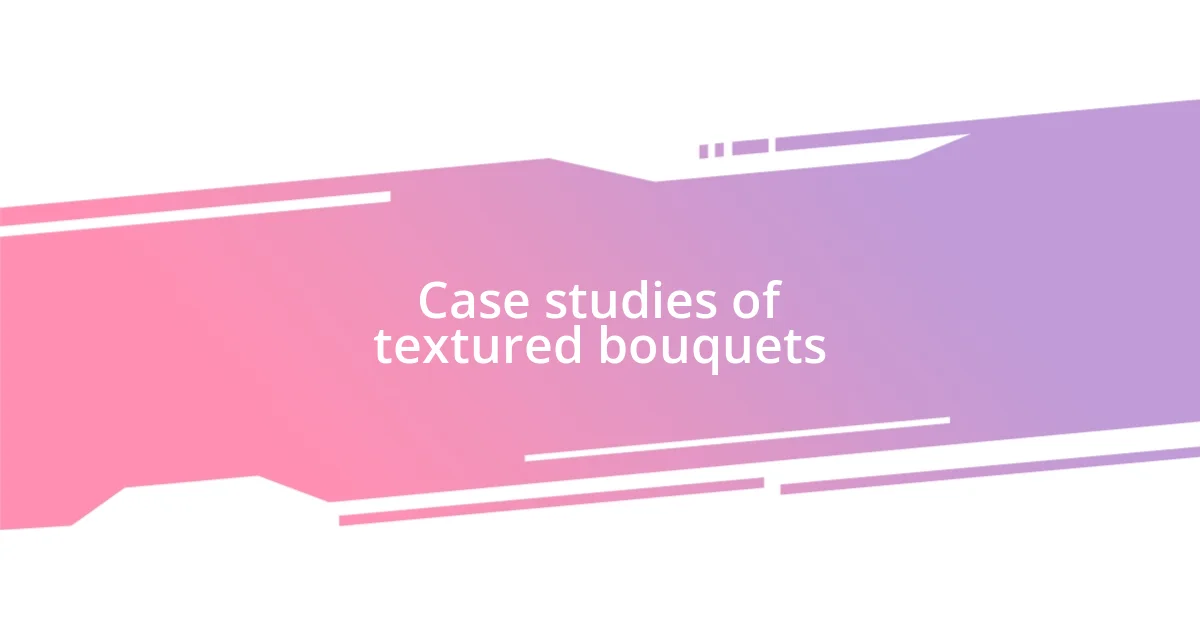
Case studies of textured bouquets
Creating textured bouquets is not just about aesthetics; it can significantly influence the overall expression of the design. For instance, I once crafted a bouquet using a mix of textured roses and delicate thistles. The roses, with their velvety petals, provided a romantic base, while the spiky thistles added a touch of quirky charm. When a friend received it as a gift, their delighted gasp spoke volumes. It made me realize how texture can evoke an emotional response, transforming a simple arrangement into a memorable gift that resonates with the recipient.
In another case, I experimented with the concept of juxtaposing hard and soft textures within the same bouquet. I combined sturdy eucalyptus leaves with fluffy astilbe. The contrasting textures created a beautiful dialogue, almost like a conversation between two personalities. I vividly recall watching my grandmother’s eyes light up as she arranged the blooms in her favorite vase. The moment reminded me of how textures can tell stories and connect generations, sparking memories through their unique interactions.
Just the other day, I created a bouquet for a friend’s anniversary, incorporating both smooth hydrangeas and rough, dried twigs. Each twig told a story of resilience, while the hydrangeas exuded love and tenderness. When I delivered it, my friend remarked that the bouquet felt like a celebration of their journey together—how powerful is that? It’s fascinating to think about how the textures not only enhance the visual appeal but can also capture the essence of significant moments in our lives. What stories do your bouquets tell?
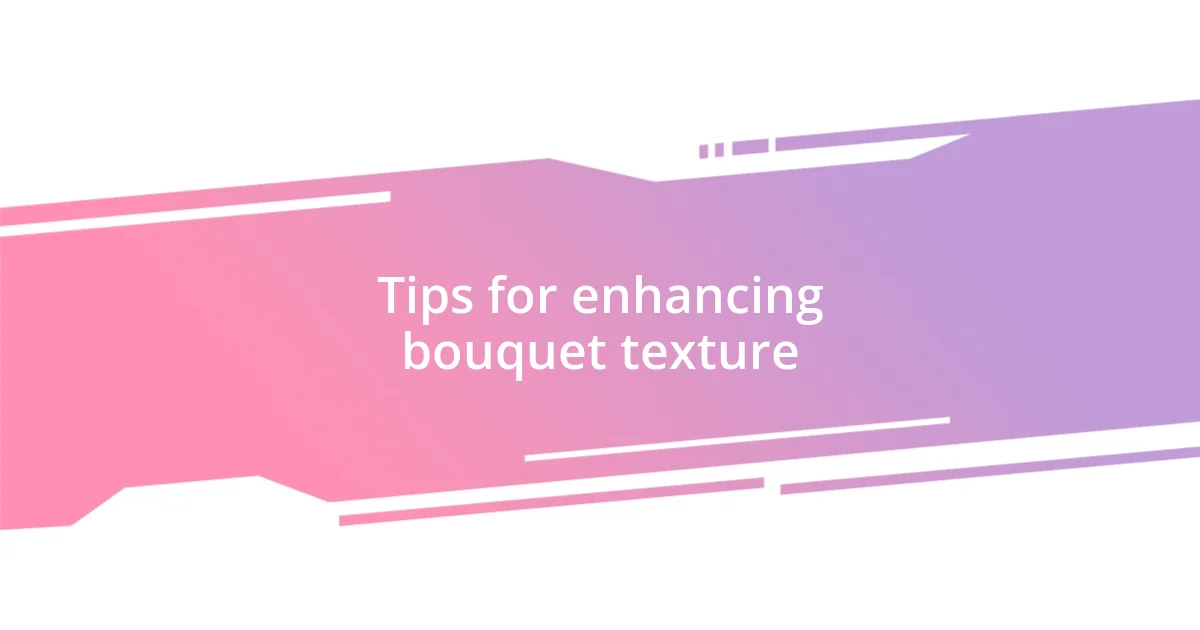
Tips for enhancing bouquet texture
One of the simplest ways to elevate bouquet texture is to play with various heights and shapes among your selected blooms. When I arrange flowers, I often mix tall, spiky elements with round, fluffy blossoms. For example, I once added towering delphiniums alongside compact peonies, which created a captivating contrast. It felt like the bouquet was reaching for the sky while grounded by the peonies’ lushness. Have you ever noticed how different shapes can create depth and movement, turning a bouquet into a more dynamic piece of art?
Another tip is to incorporate unexpected materials. I’ve been surprised at how items like ribbons, feathers, or even fruits can enhance the overall texture of a bouquet. I remember a unique arrangement where I added some vibrant poppy pods among the flowers. Their interesting shape and texture sparked curiosity and made the bouquet a conversation starter. Isn’t it fascinating how a simple addition can trigger so many delightful conversations?
Don’t underestimate the impact of foliage either! I love using a variety of leaves, especially those with bold patterns or textures, to complement the flowers. For instance, placing glossy, dark leaves from a magnolia tree alongside soft, wispy ferns can create depth. I once designed a bouquet featuring this contrast and witnessed everyone admire how the foliage seemed to frame the blooms beautifully. What textures resonate with you in your own arrangements? It’s incredible how thoughtfully selected foliage can truly enhance the bouquet experience.

